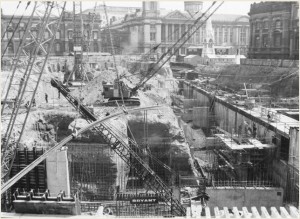Alan Clawley brings us a potted history of John Madin’s Central Library in Birmingham.
Birmingham’s Central Library came into being in 1974 when Harold Wilson MP officially opened the new building. Its predecessor, the Victorian Central Reference Library still stood next to it awaiting demolition. Nearby the new Birmingham Repertory Theatre designed by Graham Winteringham had been open for three years, in what was to become Centenary Square. Cinema-goers had seen Stanley Kubrick’s controversial film of the Anthony Burgess novel ‘A Clockwork Orange’ set in the modernist concrete council estate known as Thamesmead in east London. Birmingham City Architect, Alan Maudsley had recently been arrested on charges of corruption and resigned in disgrace. Left wing broadsheet ‘Grapevine’ had published a critical article on the almost completed Central Library.
Soon after the Library was opened the Oil Price shock hit. The West Midlands motor manufacturing industry suffered more than most. The Labour government set up a new West Midlands County Council to co-ordinate the strategic services of the eight Metropolitan District Councils. The government’s Department of the Environment commissioned three consultants to carry out studies of the problematic ‘inner city’. Stockwell, Toxteth and Small Heath were chosen as subjects.
When he opened the new library Harold Wilson was Leader of the Opposition having lost the 1970 general election to Edward Heath and had not yet regained power in the coming 1974 election. Opening the largest municipal library in Europe was a perfect role for a man who built his political success on the idea of modernising Britain’s tradition-bound institutions. Its striking modern style was entirely free from any reference to the past other than its close proximity to its ornate and cluttered Victorian predecessor that was about to be demolished despite the protests of the local Victorian Society. The new library precisely symbolised modernity. It posed a stark contrast with the paternalist era of local government epitomised by Joseph Chamberlain.
The newspaper reports were glowing. The Evening Mail quoted Wilson describing the Library as ‘a great leap forward’. The Opposition leader described it as “a proud achievement for all parties in the city”. The Mail reported that the complex was regarded as the finest provincial library in Europe. Mr Wilson unveiled a plaque to open the library officially in front of council representatives and civil officials. Before the ceremony he paid a lightning visit to the children’s department, for which he was full of praise. “It must be a tremendous boon for the mothers of the city to go shopping and leave their children here for a couple of productive and creative hours,” he said. Mr Wilson paid tribute to the work of Mr Denis Howell, Labour MP for Small Heath, who had given the scheme final approval. “The opening of this library is an act of faith in meeting the needs and creating the demand of the future”, said Mr Wilson. “We hear that television and radio have supplanted reading, but the growth rate in public library lending is 130 per cent since 1947.”
The Lord Mayor of Birmingham, Councillor Mrs Marjorie Brown, thanked Mr Wilson for help in the “difficult days” before the finances had been approved. Some members of the minority Conservative group on the City Council carried out their threat to boycott the ceremony But Alderman Neville Bosworth and Alderman Sir Francis Griffin attended. The architectural press also gave the new library its seal of approval. The Architects’ Journal 22nd May 1974 published an appraisal by Robert Ribet, an architect in private practice and a regular contributor to the AJ. He wrote, ‘ It is perhaps the use of escalators that keys the building’s success. Lifts would have compartmented the various areas unacceptably; stairs would have been noisy and exhausting. As it is one glides through the succession of volumes smoothly, sleekly. The impression is of one space flowing into the next within the depth of the huge structure, from the bright bustle of the lending library to the solid quiet of the study areas. Experience of the interior is therefore complete in a way that must be rare in this age. Few buildings can be so magically free of irritatingly endless series of wire-glass fire doors, to be met everywhere in public buildings.
The economic crisis had an immediate and disastrous impact on the future maintenance of the building and the quality of the public domain that surrounded it due to severe cuts in local government budgets. Economies had already been imposed on Madin’s specification for the cladding. The choice of a cheaper pre-cast concrete specified by the City Architect Alan Maudsley would resonate twenty years later when a bit fell off narrowly missing a member of the public. Now the series of water features and pools were cut out to save money and the comprehensive development of the rest of the site to the north of the Library that was to comprise a municipal Sports Institute was deferred indefinitely.
